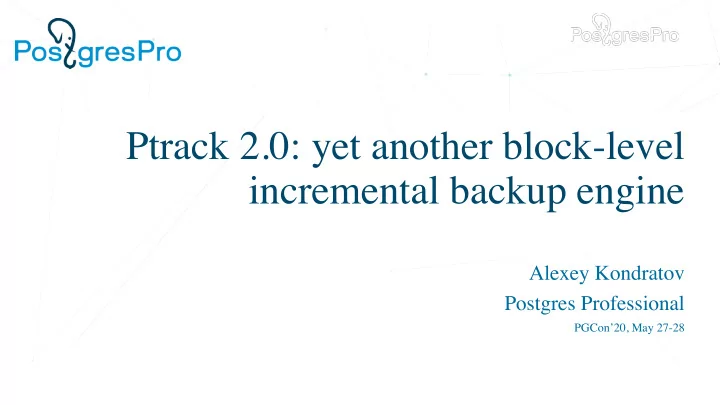

Ptrack 2.0: yet another block-level incremental backup engine Alexey Kondratov Postgres Professional PGCon’20, May 27-28
Outline o Motivation: incremental backups o How Postgres works with data? o Ptrack 1.0 recap o Ptrack 2.0 overview • In-memory data structure and operations • Durability o Limitations o Public SQL API and configuration o Benchmarks 2
Incremental backup o Only 50% out of our 10 GB database has changed since the last backup. o Copy only those 5 GB during incremental backup instead of full 10 GB . o Spend twice as less disk space and time. o Profit! 3
Incremental backup strategies o PAGE *: scan all WAL files in the archive from the moment of the previous full or incremental backup. Newly created backup contains only those pages that were mentioned in WAL records. o DELTA *: read all data files in PGDATA directory, compare LSNs and copy only those pages, that where changed since previous backup. * pg_probackup terminology 4
Incremental backup strategies o PAGE *: scan all WAL files in the archive from the moment of the previous full or incremental backup. Newly created backup contains only those pages that were mentioned in WAL records. o DELTA *: read all data files in PGDATA directory, compare LSNs and copy only those pages, that where changed since previous backup. o PTRACK : PostgreSQL tracks page changes on the fly, so we receive a ready to execute map of modified blocks. * pg_probackup terminology 5
How Postgres works with data? 6
How Postgres works with data? Code example: heapam.c > heap_insert() 7
Ptrack 1.0 recap o Use the same Buffer/Storage Manager machinery from PostgreSQL for Ptrack data pages. o Add another relation fork *_ptrack in addition to *_fsm / *_vm . o Track page modification in each place, when it is done. o Read and reset Ptrack map after pg_start_backup (). 8
Ptrack 1.0 recap Catch page modification here 9
Ptrack 1.0 recap Code example: heapam.c > heap_insert() We must track page modification before critical section 10
250+ places to track page modification! 11
250 250+ places to track page modification! 12
Ptrack 1.0 drawbacks o Cannot mark blocks in a single place like MarkBufferDirty (), since it is called inside critical section. o Too many places to put tracking routine call, too easy to miss some of them. o Fused into PostgreSQL core. o One extra file per relation. o Additional workarounds to prevent data loss during Ptrack map reset. 13
Ptrack 2.0: can we do better? 14
Ptrack 2.0 overview Let’s track page, when it actually hits disk 15
Ptrack 2.0 overview o Postgres mostly modifies everything via Buffer manager, so we can catch these operations at the very bottom level, when the affected pages are evicted back to disk . o Pages on replica and during redo process follow the same path, so there is no additional work to do. o However, there are certain operations where Postgres simply copies the entire directory with all its content: CREATE DATABASE , ALTER DATABASE … SET TABLESPACE . 16
Ptrack 2.0 hooks Ptrack core patch adds following hooks: o smgrwrite() / mdwrite() hook o smgrextend() / mdextend() hook o copydir() hook o Checkpoint (ProcessSyncRequests) hook Only four places instead of 250 = win ! 17
Ptrack 2.0 structure o Use a single cluster- wide map of a fixed size for modified page LSNs tracking. o Load it in memory from the file using mmap(). 18
Ptrack 2.0 structure Map database Oid , tablespace Oid , r elation Oid , fork number , and block number into a cell in the Entries LSN array. 19
Ptrack 2.0 operations Put new LSN value into the map using atomic operation. 20
Ptrack 2.0 durability Durably flush Ptrack map to disk during checkpoint: 1. Keep ptrack.map file since last checkpoint intact . 2. Read Ptrack map records atomically one by one into the local buffer. 3. Write buffer content into a transient file ptrack.map.tmp . 4. Calculate CRC checksum and write it at the end of file. 5. Durably replace ptrack.map with newly created ptrack.map.tmp . 21
Ptrack 2.0 limitations o Due to the fixed size of Ptrack map there are may be false positives, but never false negatives . However, with 64 MB of map you can track per- block changes in a 64 GB database without false positives . o You can only use Ptrack safely with wal_level >= 'replica' , since certain commands are designed not to write WAL at all if wal_level is minimal. o Currently, you cannot resize Ptrack map in runtime, only on postmaster start . 22
Ptrack 2.0 public SQL API o ptrack_version () — returns Ptrack version string. o ptrack_init_lsn () — returns LSN of the Ptrack map initialization. o ptrack_get_pagemapset ('LSN') — returns a set of changed data files with bytea bitmaps of changed blocks since specified LSN. 23
Ptrack 2.0 configuration o The only one configurable option is ptrack.map_size (in MB). o To completely avoid false positives it is recommended to set ptrack.map_size to 1 / 1000 of expected PGDATA size. o To disable Ptrack and clean up all remaining service files set ptrack.map_size to 0 . 24
Ptrack 2.0 usage 25
Ptrack 2.0 benchmarks o tmpfs partition, ~1 GB database (pgbench scale = 133 ), all defaults. o No pgbench_tellers and pgbench_branches updates to lower lock contention. o pgbench -s133 -c40 -j1 -n -P15 -T300 -f pgb.sql ptrack.map_size, MB REL_12_STABLE 32 64 256 512 1024 TPS 16900 16890 16855 16468 16490 16220 26
Open source Ptrack and pg_probackup are available on GitHub: o github.com/postgrespro/ptrack o github.com/postgrespro/pg_probackup 27
Feedback If you have any questions or comments: o kondratov.aleksey@gmail.com o github.com/ololobus o twitter.com/ololobuss Thank you! 28
Recommend
More recommend